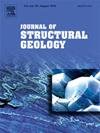与质运相关的软沉积褶皱的微观结构和变形机制
IF 2.9
2区 地球科学
Q2 GEOSCIENCES, MULTIDISCIPLINARY
引用次数: 0
摘要
软沉积变形构造(SSDS)是沉积物质在重要成岩作用或岩化作用之前变形的结果,可以由各种触发因素引起,包括物质搬运(滑动、滑坡和泥石流)。以往有一些关于块体搬运沉积(MTDs)内部的SSDS及其变形机制的研究,但大多数只考虑宏观到中尺度的数据(露头和手标本),导致缺乏对变形机制的微观分析。在这项工作中,我们研究微观结构,旨在解释在MTDs中常见的褶皱形成中涉及的变形机制,旨在创建这些结构的纲要。利用巴西南部paran本文章由计算机程序翻译,如有差异,请以英文原文为准。
Microstructures and deformation mechanisms of mass transport-related, soft-sediment folds
Soft-sediment deformation structures (SSDS) are the result of deformation in sedimentary material before significant diagenesis or lithification, and they can result from various triggers, including mass transport (slides, slumps and debris flows). There are several previous works on SSDS within mass-transport deposits (MTDs) and their deformation mechanisms, however most of them consider only macro-to mesoscale data (outcrops and hand specimens), resulting in a lack of microanalysis of deformation mechanisms. In this work we investigate microstructures aiming to interpret deformation mechanisms involved in the formation of folds commonly found in MTDs, aiming to create a compendium of these structures. Using samples from two evolved (highly homogeneized) MTDs in the Permo-Carboniferous Itararé Group, Paraná Basin, southern Brazil, we analyze structural styles in thin sections and discuss their occurrence, geometry and deformation mechanisms. Structural analysis reveals a diverse range of folds resulted from buckling-dominated and bending-dominated folding processes, whose formation was influenced by variations in sediment cohesion, layer thickness and rheology. The absence of cataclasis and early diagenetic minerals, along with grain alignment to fault planes and fold axial surfaces, indicates that deformation occurred under low confining stress prior to lithification, driven by granular flow. Local variations in cohesion within sand- and silt-rich layers are attributed to pore-fluid pressure fluctuations. The findings suggest that the primary deformation mechanism involves progressive shearing of water-saturated sediment, enhanced by liquefaction and fluidization processes.
求助全文
通过发布文献求助,成功后即可免费获取论文全文。
去求助
来源期刊

Journal of Structural Geology
地学-地球科学综合
CiteScore
6.00
自引率
19.40%
发文量
192
审稿时长
15.7 weeks
期刊介绍:
The Journal of Structural Geology publishes process-oriented investigations about structural geology using appropriate combinations of analog and digital field data, seismic reflection data, satellite-derived data, geometric analysis, kinematic analysis, laboratory experiments, computer visualizations, and analogue or numerical modelling on all scales. Contributions are encouraged to draw perspectives from rheology, rock mechanics, geophysics,metamorphism, sedimentology, petroleum geology, economic geology, geodynamics, planetary geology, tectonics and neotectonics to provide a more powerful understanding of deformation processes and systems. Given the visual nature of the discipline, supplementary materials that portray the data and analysis in 3-D or quasi 3-D manners, including the use of videos, and/or graphical abstracts can significantly strengthen the impact of contributions.
 求助内容:
求助内容: 应助结果提醒方式:
应助结果提醒方式:


